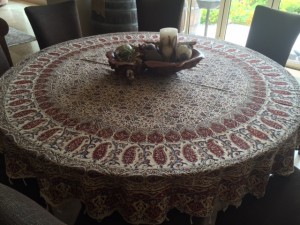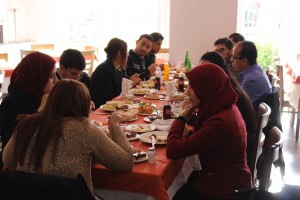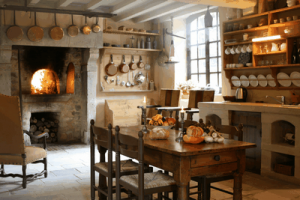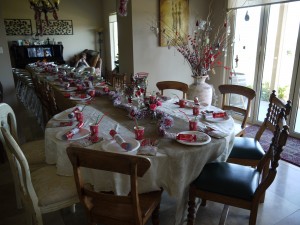If you really want to make a friend, go to someone’s house and eat with them … the people who give you their food give you their heart.
– Cesar Chavez
The dining room table is a most significant and symbolic piece of furniture in my life. It invokes childhood memories of joy and lament, of delicious meals, of arguments, jokes, intense debate and tantrums. It recalls the many different faces that shared the table with my parents and I, and the lives and stories they represented. My parents welcomed many people to the table.
Today we have a large, circular, red gum table that dominates our dining room. It is so heavy you can’t lift it. It is round to remind those who gather there that there is no hierarchy. Many nights it has family, friends and strangers crammed around it. The conversations are as diverse as the people that hold them – laughing, joking, angry, opinionated, silent, sullen, quiet, peaceful, heart-felt and sometimes simply exhausting. Mouths crammed with food with water and wine being passed from one to the other, we defy every meal etiquette. Politics and religion, no doubt, will always be discussed! I often stop and look around with deep gratitude. There is no better place than to be seated by a table, sharing a meal, sharing our lives.

Tables have been around for literally ages. Different designs were used by different civilisations. Egyptians used wood or stone and their tables were fashioned like pedestals, the Assyrians used metal, Greeks used bronze, others used marble. The use of tables evolved over time and it was in the 16th century that the dining table really came into its own. The earliest Western tables were simple wooden boards on trestles that were set up for eating and then packed away. Today tables come in all shapes and sizes and man-made materials like plastic or fibreglass.
The dining table has held emblematic significance throughout the ages. It symbolises unity, celebration, togetherness, belonging, and acceptance. Cultures across the world view the dining table as very significant. It is t he heartbeat of a home. The importance of sharing meals features in many religions, like the sharing of the Shabbat meal amongst Jews, or the house-hopping and sharing of meals during Eid al-Fitr for Muslims, or the sharing of the Lord’s supper amongst Christian faith traditions.
he heartbeat of a home. The importance of sharing meals features in many religions, like the sharing of the Shabbat meal amongst Jews, or the house-hopping and sharing of meals during Eid al-Fitr for Muslims, or the sharing of the Lord’s supper amongst Christian faith traditions.
 he heartbeat of a home. The importance of sharing meals features in many religions, like the sharing of the Shabbat meal amongst Jews, or the house-hopping and sharing of meals during Eid al-Fitr for Muslims, or the sharing of the Lord’s supper amongst Christian faith traditions.
he heartbeat of a home. The importance of sharing meals features in many religions, like the sharing of the Shabbat meal amongst Jews, or the house-hopping and sharing of meals during Eid al-Fitr for Muslims, or the sharing of the Lord’s supper amongst Christian faith traditions.In ancient traditions, eating together was a way of forming and forging relationship. It was a sign of acceptance and reconciliation. Ancient Israel had strict dietary laws and maintained clear social and religious boundaries – it was very important to obey laws surrounding what you ate and who you ate with! No wonder Jesus was so irksome to a religious establishment that saw his total disregard of meal protocol and tradition as dangerous. He invited himself to the table of ‘filthy’ tax collectors! This wasn’t just a little step over the etiquette boundary. It was the flipping of the proverbial middle finger to the carefully constructed boundaries that ensured racial and religious purity. This rebel seemed to think that all were invited to God’s table – what a ridiculously scandalous idea. A table without boundary or exclusion?? One commentator suggested that Jesus got himself crucified by the way he ate.
In our hurry-sick world, suffering from a loneliness epidemic, it is time to bring the table back to centre stage. It is time to remind ourselves that we become better people when we welcome others to the table. People from all walks of life, people who are different to us, who may not share our views or faith. Something miraculous happens around a table, whether in a home, restaurant, workplace, a table carved of sand on the beach, or flimsily thrown together in small huddles in our faith communities. That moment of sharing food and stories deepens us like no social media network ever could. In times of violence and sadness in our world we need to remind ourselves of our shared humanity and refresh ourselves with new hope and courage in each other’s company. Around a table we don’t just nurture our bodies with food, we heal each others soul.
I want to live my life with a welcome sign on my table. A place where the stranger can find refuge, where the hungry can be fed, where the marginalised can be affirmed and accepted, and where the sad heart can find hope. I often fail in this endeavour but I will not give up. To me that round red gum table reminds me of welcome and belonging, it reminds me of amazing grace, and most of all it reminds me that love is greater than fear. Welcome to the table.
And Mephibosheth lived in Jerusalem, because he always ate at the king’s table; he was lame in both feet … II Samuel 9


I like this. 🙂
When I was a kid my parents never really practiced the notion of dinner around a table – it was always dinner in front of the tv. But my grandparents always insisted on meals around the table, and often invited strangers and people outside the family for Christmas. I’ve tried to emulate their example… at the very least just by insisting that for one meal a day we sit down together as a family. (And definitely no tv!)